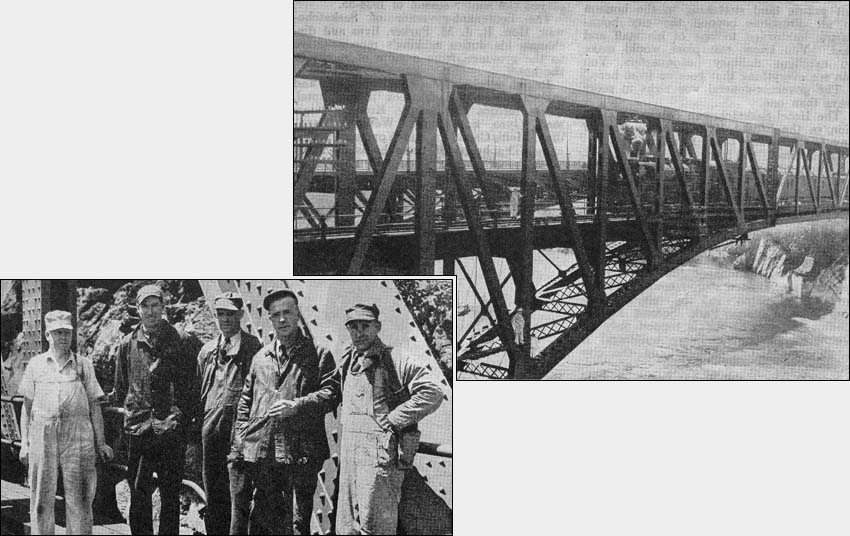
Canadian Pacific Staff Bulletin - September, 1946

BOTTOM: "Just watch where you're going." That is the advice offered by Foreman W.F. O'Neil when quizzed on the finer points of bridge painting. Mr. O'Neil is seen at extreme left accompanied by members of his gang. Others are, V.A. Burns, J.L. Ball, F.M. Graham, and W.H. Quigg.
The average citizen of Saint John, New Brunswick, might think that painting the CPR bridge over the
famous Reversing Falls, while the current races by at full speed 80 feet below, would be one of the city's most
undesirable jobs.
ut to W.F. O'Neil, foreman, who has superintended every painting of the bridge since its first repaint job in 1924, it's all in the day's work.
"You get used to it," he claims. "The main thing is not to look down, just watch where you're going."
Foreman O'Neil has a Company gang working on the bridge right now. The six men, working for three months, will paint about a third of the bridge's 1,200 foot length this summer. With sections of the bridge earmarked for painting each year, the entire structure is covered in approximately four years.
As the danger of corrosion is particularly acute in the salt air of the coast, the bridge has been repainted about six times since it was first used in 1919.
Mr. O'Neil began his painting aprenticeship on the old Cantilever Bridge at Saint John in 1912 under the late E.D. Graham and became a foreman in 1922. Since he began, he has worked on all the more than 100 bridges on the Brownville division, the only division on which he has been employed.
The Company's bridge gangs in New Brunswick have been notable for family records, says Mr. O'Neil. Four sons of his old foreman, Mr. Graham, are railway bridge painters now, along with four Allen Brothers and three Quigg brothers. Two of the Quiggs, two of the Allens, and one Graham are working in his crew.
Despite what may appear risky spots in which the work is carried on, bridge painting is a relatively safe job, the veteran foreman avers. That is because the painters take no chances. In his 34 years' experience at the work, there have been no injuries.
The most important precautions to ensure safety in bridge painting lie in making fast all stagings and in providing ropes or other handholds where necessary.
An eye is also kept on the weather during the job. No top work is done when a high wind is blowing, and when it is raining, jobs are found under cover.
Mr. O'Neil figures that a complete painting of the Reversing Falls Bridge requires 600 gallons of graphite, 1,500 pounds of red lead, and about 1,000 gallons of gasoline to operate the air compressor which provides power for the chipping hammers and wire brushes which clean off the old paint and the sprayers which apply the new coat.
 and is reprinted here with their permission. All photographs,
logos, and trademarks are the property of the Canadian Pacific Railway Company.
and is reprinted here with their permission. All photographs,
logos, and trademarks are the property of the Canadian Pacific Railway Company.